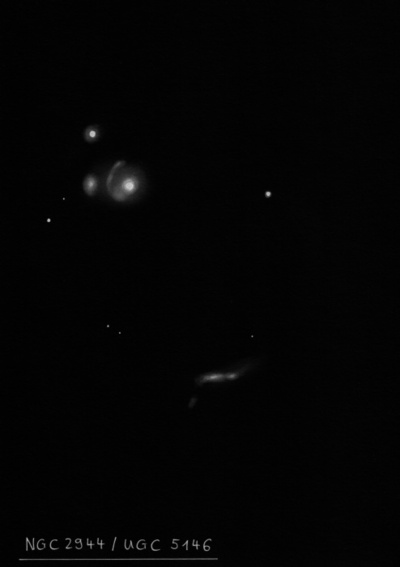
Johann Palisa discovered NGC 2944 on 27 Mar 1886 with the 12-inch refractor at the Vienna University Observatory. His micrometric position in AN 2782 matches UGC 5144. This is a disrupted double or triple system in contact. The listed dimensions (from UGC) are for the combined system. The same night Palisa also discovered NGC 2926 and Samuel Oppenheim discovered NGC 2981. See Harold Corwin's identification notes.
NGC 2944 is in the Arp category of Spiral Galaxies with small, high surface-brightness companions on arms. Vorontsov-Velyaminov also considered this a pair of galaxies, although VV 82a appears to be double itself.
400/500mm - 17.5" (4/25/98): extremely faint, very small, elongated 2:1 ~E-W, slightly brighter core but overall low surface brightness. Collinear with two mag 13 stars 3.4' and 4.4' NE. This double system was not resolved under noticeably hazy sky conditions and soft seeing. UGC 5146 = Arp 129, another double system, lies 3.7' NE.
900/1200mm - 48" (4/18/15): At 697x, this double (or possibly triple) system appeared moderately bright, very elongated 3:1 E-W, ~36"x12", weak concentration. A small roundish knot (SDSS J093916.79+321837.7 ) attached at the west end has a moderately high surface brightness and a diameter of 8"-10". On the SDSS this "knot" appears to be the core of a merged interacting companion! VV 82b is another interacting companion, just 27" SE of center. It appeared extremely faint, very small, round, 10" diameter. It was only visible with averted for short periods. PGC lists a photographic mag of 18.6.
The double system Arp 129 = VV 83 = UGC 5146 is 3.5' NNE. At 697x; the eastern component appeared moderately to fairly bright, small, round, high surface brightness, ~20" diameter. A mag 12 star, superimposed on the western component VV 83a = MCG +06-21-071 is just 30" WSW. The western component of Arp 129 appeared fairly faint, fairly small, roundish, nearly even surface brightness? Although easily visible, the view is significantly impaired by the 12th magnitude star and the galaxy was only visible on the east side of the star.
Notes by Steve Gottlieb